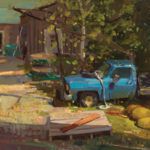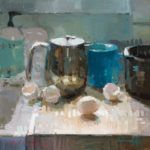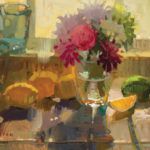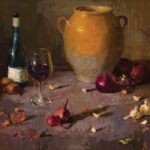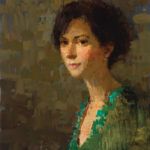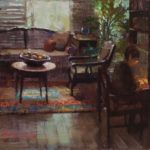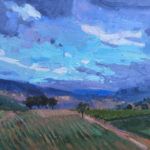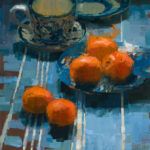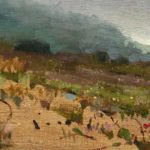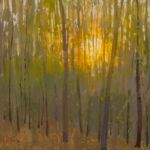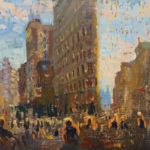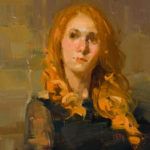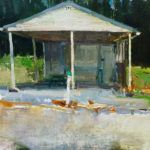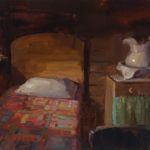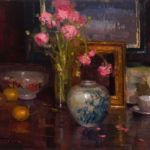Aimee Erickson paints what her eyes and her inner vision perceive
By Gussie Fauntleroy
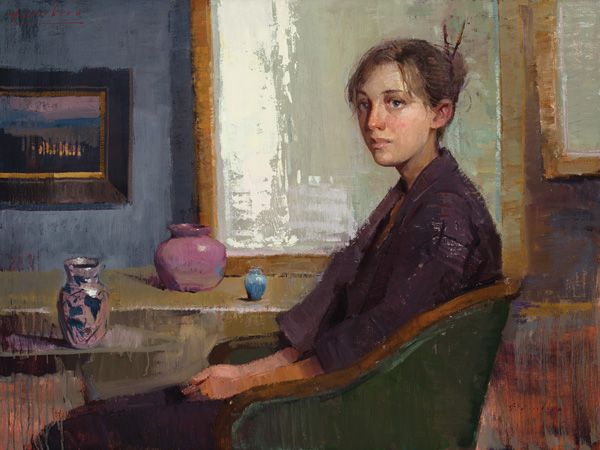
Aimee Erickson, Seeing Through, oil, 30 x 40.
This story was featured in the April 2018 issue of Southwest Art magazine. Get the Southwest Art May 2018 print issue or digital download now–then subscribe to Southwest Art and never miss another story.
Aimee Erickson once read an account of painter John Singer Sargent’s studio style that intrigued and delighted her. According to one of Sargent’s models, there were days when the painter would work tirelessly all day. But other days—seemingly oblivious to the waiting model—instead of moving to his easel, he would go to the piano he kept in his studio and play all day. “That’s inspiring to me, because when it comes to being in the flow of painting, you’re not always in charge of it,” Erickson says. “Sometimes you just have to be as present as you can and let it come. You invite it, but you don’t try too hard.”
When she’s painting outdoors on location, the act of approaching her subject is equally receptive. “I don’t seek something to paint so much as wait,” says the 51-year-old Portland, OR, artist. “It’s a kind of circling. I might just hang out a bit and tune in to the day.” At official plein-air events, of course, her circling and waiting is usually limited by time constraints. Yet the response to her landscapes suggests that even in circumscribed conditions, Erickson is well tuned-in when she paints. In 2017 alone she earned Best of Show at three major plein-air events: the Laguna Beach Plein Air Painting Invitational in Laguna Beach, CA; Pacific Northwest Plein Air in Goldendale, WA; and the Olmsted Plein Air Invitational in Atlanta, GA, where she also received the Clyde Aspevig Judge’s Choice and Best Quick Paint awards.
- Aimee Erickson, Crane Truck, oil, 14 x 18.
- Aimee Erickson, Kitchen Counter Blue, oil, 12 x 12.
- Aimee Erickson, Kitchen Window, Lemons, oil, 14 x 20.
Erickson’s still-life painting process starts with a different kind of waiting, which she calls the gathering phase, in which interesting objects gather on her studio shelves and wait. Among these: dozens of glass jars from the 1940s and ’50s, found in an ad hoc garbage dump. They were containers for everyday household products, each with a specially designed glass jar. “I like to have lots of materials, lots of choice, and then just use a few,” the painter says. “One of the things I’ve learned is to be generous to my inner artist child.”
As an actual child, Erickson gave generous attention to her creative side, learning to paint in oils by age 6. But her parents also encouraged their five children to explore all kinds of activities for fun. For Aimee that meant hanging out in her favorite tree, baking cookies and cakes from scratch, teaching herself to ride a unicycle, and practicing gymnastics, cello, and ballet. Born in Paris, where her American physicist father was working at a linear accelerator outside the French capital, she grew up mostly in Sunnyvale, CA. While she loved to paint, the family held academics in high esteem and considered art a hobby. Throughout high school, Erickson had no idea it could be a career.
Her first glimpse at that possibility came while studying design at Utah’s Brigham Young University, where she earned a Bachelor of Fine Arts in visual communication design. The school’s design department offered the same foundational art program for students heading toward illustration and graphic-design degrees. It was the perfect entry point for an artist who later translated a strong inherent sense of color and composition into a broad range of freelance creative jobs, from architectural color consulting to illustration, murals, and scenic design. “If you learn design, you can pick up so many media—the principles are the same,” she says.
- Aimee Erickson, Onions and Confit Pot, oil, 24 x 30.
- Aimee Erickson, Sharon, oil, 18 x 14.
- Aimee Erickson, The Writer, oil, 14 x 18.
In 1997, Erickson became the first female artist selected to paint the State of Oregon’s official gubernatorial portrait, that of Governor Barbara Roberts. It was only the second commissioned portrait she had done. Most of her time in those days was divided between oil painting for herself and freelance design and illustration work. But in the following years, two significant events took place that helped focus her personal and creative energy and gave her the confidence to put her art out into the larger world.
The first was a two-month bicycling adventure across the United States, from California to Florida. Riding with a dozen other cyclists, Erickson took along her sketchbook and watercolors, experiencing and responding to the country’s vastly diverse landscape. Through the repetitive movements of cycling, and with time to reflect and a continent to see, old thought patterns fell away and a clearer sense of what she found meaningful began to arise. This renewed self-understanding eventually transformed both her spiritual beliefs and her art.
Then, in the spring of 2014, Erickson signed up for the Carmel Art Festival’s juried plein-air competition, her first such event outside the Pacific Northwest. Carmel attracts nationally known artists, and Erickson found herself daunted as she read the list of names. But the setting was gorgeous, and she had already decided that her goal was simply to enjoy the experience. As it turned out, the rewards were far greater than that. When the winners were announced, Erickson’s work had been chosen for Best of Show, Honorable Mention, and People’s Choice. “I had to change my self-perception,” she says. “I couldn’t play it small anymore.” In 2017, along with earning top awards at multiple plein-air events, she accepted an invitation to spend two weeks painting in Russia.
There are a number of masterful artists whose style and approach to painting Erickson finds inspirational in a direct way. She has studied with some of them, including Sherrie McGraw, David Leffel, Burton Silverman, and Stephen Hayes. But there are also indirect influences, things that tend to shift her state of mind or shape her way of perceiving the world. Among these is the work of former U.S. Poet Laureate Billy Collins. “Billy Collins has a lovely way of starting off with a small, ordinary observation, and then out of nowhere it becomes something really profound,” she says. “That connection between the everyday and the profound inspires me.”
- Aimee Erickson, Before the Rain, oil, 11 x 14.
- Aimee Erickson, Blue and Apricots, oil, 16 x 12.
- Aimee Erickson, Brightening, oil, 7 x 12.
As she unpacks boxes in her new studio, with its high ceiling and abundant light, Erickson reflects on the direction her art may take in the new space. While the specifics are open-ended, she is excited by what she sees emerging. “I feel like there’s a distillation process going on,” she says. “I really like simple paintings—they feel strong to me. I ask myself, how can it become more simple and essential? It’s not about the object so much as the essence of some quality of light and feeling.”
KITCHEN COUNTER BLUE, painted in a friend’s kitchen while the studio was under construction, exemplifies this approach. Eggshells, mugs, and a small reflective coffeepot on a countertop are loosely defined and shot through with suggestions of color and light. The painting “has the kind of freedom that really feels free to me,” she says. “You can feel the paint moving in and across and through it. The objects are described by light and form but not based on solid edges.” Intrigued by the idea that something can be two things at once, the artist is especially inspired by the double life of paint. “You can put paint down as paint, and yet the brain can see it as something else,” she says.
Another aspect of art’s dual nature revealed itself when Erickson was a young painter working on her first commissioned portrait. The subject was a teenage girl whose mother commissioned the painting. The girl herself was not that interested and presented herself as cool and aloof. But when her mother saw the completed painting, tears of love rolled down her face. Erickson had portrayed the girl’s reserved exterior, yet somehow she also captured a glimpse of the young, tender, and growing child inside. The painter, perhaps subconsciously, was able to apprehend and express both aspects at once.
- Aimee Erickson, Driveway Sunset, oil, 14 x 18.
- Aimee Erickson, Flatiron, oil, 8 x 10.
- Aimee Erickson, How to Forget, oil, 10 x 8.
That sensitive, evocative quality emerged in a more deliberate way in the recent painting titled SHARON. Erickson began the painting from life, adeptly rendering the model’s likeness. But then she went further, adding layers of color and rhythmic brush strokes to create greater visual interest and enhance the emotional depth. “It’s interesting because I photographed the painting at an earlier stage, and it looked good,” she says. “But now it’s so much more.”
Finding meaning beneath the surface of a face or within ordinary objects is one kind of artistic gift. Another is the ability to truly see in a visual sense. When she teaches, and in her own art, Erickson frequently returns to the important connection between what we believe—or what we think we should see—and what our eyes in fact take in. She remembers riding in the car years ago with her family and exclaiming about the gorgeous shade of green in the sky. Her mother and brother didn’t even look up. “The sky is blue, Aimee,” they said. “So if you believe the sky is blue, you’ll paint it blue,” the artist observes. “Learning to see more, and being open to seeing things differently, is how we learn to paint. You can adopt a style or convention, but it won’t be the same as if it comes from how you actually see.”
representation
Meyer Gallery, Santa Fe, NM; Nancy Dodds Gallery, Carmel, CA; Meyer Vogl Gallery, Charleston, SC; Vanessa Rothe Fine Art, Laguna Beach, CA.
- Aimee Erickson, Shelter, oil, 12 x 16.
- Aimee Erickson, Simplicity, oil, 14 x 18.
- Aimee Erickson, Still Life With Ginger Jar and Ranunculus, oil, 14 x 18.
This story was featured in the April 2018 issue of Southwest Art magazine. Get the Southwest Art May 2018 print issue or digital download now–then subscribe to Southwest Art and never miss another story.
MORE RESOURCES FOR ART COLLECTORS & ENTHUSIASTS
• Subscribe to Southwest Art magazine
• Learn how to paint & how to draw with downloads, books, videos & more from North Light Shop
• Sign up for your Southwest Art email newsletter & download a FREE ebook






